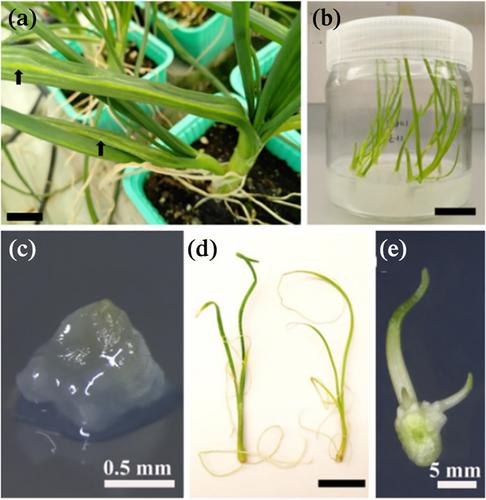当前位置:
X-MOL 学术
›
Ann. Appl. Biol.
›
论文详情
Our official English website, www.x-mol.net, welcomes your
feedback! (Note: you will need to create a separate account there.)
Combining thermotherapy with meristem culture for improved eradication of onion yellow dwarf virus and shallot latent virus from infected in vitro‐cultured shallot shoots
Annals of Applied Biology ( IF 2.2 ) Pub Date : 2020-09-25 , DOI: 10.1111/aab.12646 Min‐Rui Wang 1, 2 , Zhibo Hamborg 1 , Dag‐Ragnar Blystad 1 , Qiao‐Chun Wang 2
Annals of Applied Biology ( IF 2.2 ) Pub Date : 2020-09-25 , DOI: 10.1111/aab.12646 Min‐Rui Wang 1, 2 , Zhibo Hamborg 1 , Dag‐Ragnar Blystad 1 , Qiao‐Chun Wang 2
Affiliation

|
The present study described a combining thermotherapy with meristem culture for improved eradication of onion yellow dwarf virus (OYDV) and shallot latent virus (SLV) from co‐infected in vitro‐cultured shallot shoots. In vitro‐cultured shoots infected with OYDV and SLV were thermo‐treated at a constant temperature of 36°C for 0, 2 and 4 weeks, and then meristems (0.5 mm) containing 1–2 leaf primordia were excised and cultured for shoot regrowth. Meristem culture without thermotherapy produced much higher levels of survival (100%) and shoot regrowth (55%) than those (62% survival and 32% shoot regrowth) produced by the procedure combining 4 weeks of thermotherapy with meristem culture. However, much higher virus‐free frequencies (70% for OYSV, 80% for SLV and 50% for both viruses) were obtained in the latter than those (10% for OYSV, 15% for SLV and 10% for both viruses) obtained in the former. Histological and subcellular studies showed that thermotherapy imposed stress or damage to the cells of meristems, thus resulting in reduced meristem survival and shoot regrowth. Studies on virus location revealed considerable alternations of virus distribution patterns in the thermo‐treated meristems. The results of histological and subcellular studies and analysis of virus distribution pattern added valuable experimental data in the combining thermotherapy with meristem culture for virus eradication. These data provided explanations as to why combining thermotherapy with meristem culture improved the eradication of OYDV and SLV from the virus‐infected in vitro shallot shoots.
中文翻译:

将热疗法与分生组织培养相结合,可以更好地根除感染的体外培养的青葱芽中的洋葱黄矮病毒和青葱潜伏病毒
本研究描述了将热疗法与分生组织培养相结合,以改善根除共感染体外培养的青葱芽中洋葱黄矮病毒(OYDV)和青葱潜伏病毒(SLV)的效果。将经OYDV和SLV感染的离体培养芽在36°C的恒温下进行0、2和4周的热处理,然后切下含有1-2叶原基的分生组织(0.5 mm)并培养芽再生长。 。不进行热疗的分生组织培养比将4周的热疗与分生组织培养相结合的程序产生的存活率(100%)和枝条再生长(55%)高得多(62%存活率和32%枝条再生长)。但是,后者获得的无病毒频率要高得多(OYSV为70%,SLV为80%,两种病毒均为50%)(OYSV为10%,前者获得的SLV占15%,两种病毒的占10%。组织学和亚细胞研究表明,热疗会对分生组织的细胞施加压力或损害,从而导致分生组织的存活时间缩短和芽再生。对病毒位置的研究表明,在热处理的分生组织中,病毒的分布方式有很大的不同。组织学和亚细胞研究的结果以及病毒分布模式的分析为热疗法与分生组织培养相结合以消除病毒提供了宝贵的实验数据。这些数据解释了为什么将热疗与分生组织培养相结合能改善从病毒感染的体外小葱枝中根除OYDV和SLV的原因。组织学和亚细胞研究表明,热疗会对分生组织的细胞施加压力或损害,从而导致分生组织的存活时间缩短和芽再生。对病毒位置的研究表明,在热处理的分生组织中,病毒的分布方式有很大的不同。组织学和亚细胞研究的结果以及病毒分布模式的分析为热疗法与分生组织培养相结合以消除病毒提供了宝贵的实验数据。这些数据解释了为什么将热疗与分生组织培养相结合能改善从病毒感染的体外小葱枝中根除OYDV和SLV的原因。组织学和亚细胞研究表明,热疗会对分生组织的细胞施加压力或损害,从而导致分生组织的存活率降低和芽再生。对病毒位置的研究表明,在热处理的分生组织中,病毒的分布方式有很大的不同。组织学和亚细胞研究的结果以及病毒分布模式的分析为热疗法与分生组织培养相结合以消除病毒提供了宝贵的实验数据。这些数据解释了为什么将热疗与分生组织培养相结合能改善从病毒感染的体外小葱枝中根除OYDV和SLV的原因。对病毒位置的研究表明,在热处理的分生组织中,病毒的分布方式有很大的不同。组织学和亚细胞研究的结果以及病毒分布模式的分析为热疗法与分生组织培养相结合以消除病毒提供了宝贵的实验数据。这些数据解释了为什么将热疗与分生组织培养相结合能改善从病毒感染的体外小葱枝中根除OYDV和SLV的原因。对病毒位置的研究表明,在热处理的分生组织中,病毒的分布方式有很大的不同。组织学和亚细胞研究的结果以及病毒分布模式的分析为热疗法与分生组织培养相结合以消除病毒提供了宝贵的实验数据。这些数据解释了为什么将热疗与分生组织培养相结合能改善从病毒感染的体外小葱枝中根除OYDV和SLV的原因。
更新日期:2020-09-25
中文翻译:

将热疗法与分生组织培养相结合,可以更好地根除感染的体外培养的青葱芽中的洋葱黄矮病毒和青葱潜伏病毒
本研究描述了将热疗法与分生组织培养相结合,以改善根除共感染体外培养的青葱芽中洋葱黄矮病毒(OYDV)和青葱潜伏病毒(SLV)的效果。将经OYDV和SLV感染的离体培养芽在36°C的恒温下进行0、2和4周的热处理,然后切下含有1-2叶原基的分生组织(0.5 mm)并培养芽再生长。 。不进行热疗的分生组织培养比将4周的热疗与分生组织培养相结合的程序产生的存活率(100%)和枝条再生长(55%)高得多(62%存活率和32%枝条再生长)。但是,后者获得的无病毒频率要高得多(OYSV为70%,SLV为80%,两种病毒均为50%)(OYSV为10%,前者获得的SLV占15%,两种病毒的占10%。组织学和亚细胞研究表明,热疗会对分生组织的细胞施加压力或损害,从而导致分生组织的存活时间缩短和芽再生。对病毒位置的研究表明,在热处理的分生组织中,病毒的分布方式有很大的不同。组织学和亚细胞研究的结果以及病毒分布模式的分析为热疗法与分生组织培养相结合以消除病毒提供了宝贵的实验数据。这些数据解释了为什么将热疗与分生组织培养相结合能改善从病毒感染的体外小葱枝中根除OYDV和SLV的原因。组织学和亚细胞研究表明,热疗会对分生组织的细胞施加压力或损害,从而导致分生组织的存活时间缩短和芽再生。对病毒位置的研究表明,在热处理的分生组织中,病毒的分布方式有很大的不同。组织学和亚细胞研究的结果以及病毒分布模式的分析为热疗法与分生组织培养相结合以消除病毒提供了宝贵的实验数据。这些数据解释了为什么将热疗与分生组织培养相结合能改善从病毒感染的体外小葱枝中根除OYDV和SLV的原因。组织学和亚细胞研究表明,热疗会对分生组织的细胞施加压力或损害,从而导致分生组织的存活率降低和芽再生。对病毒位置的研究表明,在热处理的分生组织中,病毒的分布方式有很大的不同。组织学和亚细胞研究的结果以及病毒分布模式的分析为热疗法与分生组织培养相结合以消除病毒提供了宝贵的实验数据。这些数据解释了为什么将热疗与分生组织培养相结合能改善从病毒感染的体外小葱枝中根除OYDV和SLV的原因。对病毒位置的研究表明,在热处理的分生组织中,病毒的分布方式有很大的不同。组织学和亚细胞研究的结果以及病毒分布模式的分析为热疗法与分生组织培养相结合以消除病毒提供了宝贵的实验数据。这些数据解释了为什么将热疗与分生组织培养相结合能改善从病毒感染的体外小葱枝中根除OYDV和SLV的原因。对病毒位置的研究表明,在热处理的分生组织中,病毒的分布方式有很大的不同。组织学和亚细胞研究的结果以及病毒分布模式的分析为热疗法与分生组织培养相结合以消除病毒提供了宝贵的实验数据。这些数据解释了为什么将热疗与分生组织培养相结合能改善从病毒感染的体外小葱枝中根除OYDV和SLV的原因。










































 京公网安备 11010802027423号
京公网安备 11010802027423号